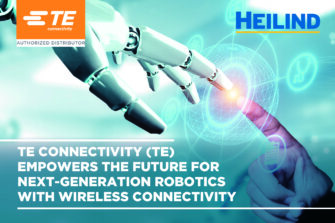Source : Mouser Electronics
In the era of Internet of Things (IoT) connectivity, Artificial intelligence (AI)-powered robotics is rising to new heights of our technological ambitions. Improved cognition capability, real-time decision-making, and smarter motor-actions have positioned robotics for higher-precision and mission-critical use cases–whether it is on a congested road, factory floor, or during a complex medical procedure.
One thing this new generation of AI/robotics applications share in common is they generate huge amounts of data that need to be reliably crunched and transported with near-zero delay (latency). The efficacy of these applications heavily relies on seamless roaming, thus requiring wireless connectivity rather than wired links at the edge.
The fifth generation of 3GPP (5G) standards incorporates this neo-vision of AI-powered robotics. In addition to supporting higher speeds and more data capacity, 5G networks are designed to enable the ambitions of a new generation of robots that will change not just our factories and offices, but also our everyday lives.
Robotics, Hi-Speed Data Crunch, and 5G
The connection between 5G networks and robotics might not be all that obvious. Historically, robotics has mostly focused on advanced electronics and AI-software to improve motion dynamics, sensory functions, cognition, etc. But IoT has expanded the scope of AI and robotics from local to global scale.
High-speed wireless networks and cloud computing are the key enablers of these connected robotics applications.
In hospitals and factories, robots have been widely used to perform mundane functions such as moving things from one place to another, perform repetitive tasks such as parts assembly, locomotion, etc. Next-generation robots take this to a new level as they can perform sophisticated functions in telesurgery, where the doctors can orchestrate the surgery remotely (possibly from the other end of the planet) while the robots would perform the actual operation based on real-time command and control.
Autonomous vehicles, unmanned drones, gyrocopters, etc., are all newer applications of AI and robotics that rely on high-speed computing and communication to make accurate, reliable decisions in real-time.
The 5G standards are designed and have been aggressively tested worldwide as a key enabler to support these connected robotics applications that heavily rely on cloud computing. AI/robotics application design would need to tie in with public cloud platforms such as Azure, AWS, GCP, etc., which would also allow them to leverage cloud-based machine learning services.
In July 2019, cloud service provider Microsoft and networking giant AT&T entered into a $2 billion (USD) multiyear alliance covering cloud, AI, and 5G. As 5G and cloud get more tightly meshed to power AI applications, cloud partnerships would become increasingly important for 5G service providers such as AT&T and Verizon to offer cloud-based 5G services.
5G Infrastructure for Robotics
One of the biggest challenges for robotics development is latency. Latency is the time it takes to send data from the source point to its destination. In the case of robotics, sensor signals are transmitted to the cloud for advanced processing, based on which commands are generated. The robot takes action based on the commands it receives from the cloud. Unless the sensor outputs and computed commands can be sent and received fast enough, the robot’s functionality is severely limited.
4G cannot offer the ultra-low latency needed by the next-gen mobile robotics applications. The latency in 4G networks is about 50ms (milliseconds). Besides, in addition to large amounts of data transport and processing, robotic systems are also sensitive to lost and erroneous data. Because of latency and instability concerns with previous generations of cellular technology, the only option to reliably transmit-receive vast amounts of data was to tether the robots with wired connectivity. 5G standards address these limitations head-on.
5G is the first 3GPP standard that promises to reduce latency to less than 1ms, offer nearly 10 times 4G bandwidth while maintaining compatibility with 4G. What this means is industries can still adopt 5G without having to worry about the longevity of their 4G networks.
Latency reduces as the source and destination points come closer. To offer ultra-low latency experience, 5G architectures would bring data processing closer to the “edge” (or the robot endpoints). Unlike 4G, where the endpoint communicates with only one cell tower, in 5G infrastructure endpoints simultaneously communicate with many towers and antennas for higher speeds and lower latency. This requires more towers and antennas and more data centers to process the data near the edge, in other words, data centers would need to geographically expand to support the 5G infrastructure.
AI-powered robots are also envisioned as the key enablers of smart, intelligent factories where industrial robots can autonomously carry out tasks or collaborate with humans (collaborative robots, or cobots) on tasks that require human intervention. Such smart factories involve a constant flow of information regarding the various processes in the manufacturing workflows. Current mobile networks are not designed for such bandwidth-intensive applications. In 5G, bandwidth can be divided into slices. These slices can run over a common network infrastructure. This would allow each aspect of the manufacturing process to utilize a different slice to reliably exchange sensory signals and robot instructions in real-time.
Final Thoughts
Ubiquitous AI/robotics applications such as telesurgery, autonomous vehicles, etc. are still at an early concept phase, and 5G is yet to be rolled out at a commercial scale worldwide. In the US, 5G commercialization is expected in 2020, and global commercialization by 2023. Although application reliability for remote robotics depends on 5G going mainstream, there are extensive alliances and partnerships between RF chipset manufacturers, cloud providers, system developers, and cellular service providers to design, develop, test, and harden 5G-enabled systems for the future.
To learn more, visit www.mouser.com












